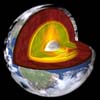
|
|
PREVIOUS ISSUE
TERRADAILY NEWS TERRADAILY WIRE SPACEDAILY MARSDAILY SPACE TRAVEL SPACEMART SPACEWAR NEWS SPACEWAR WIRE |
 Berkeley - Dec 17, 2003
Berkeley - Dec 17, 2003Radioactive potassium, common enough on Earth to make potassium-rich bananas one of the "hottest" foods around, appears also to be a substantial source of heat in the Earth's core, according to recent experiments by University of California, Berkeley, geophysicists. FRINGE Scientists Use Radar Vision To See The Earth Move  Paris - Dec 14, 2003
Paris - Dec 14, 2003Tiny ground movements that occur too gradually to be seen by the human eye can nevertheless be detected by ESA satellites looking down to Earth from 800 km away. |

|
Forecasters Can Count Lightning Strikes to Estimate Rainfall Tucson - Dec 11, 2003
Tucson - Dec 11, 2003When it comes to predicting rainfall during convective thunderstorms, lightning may be more accurate than radar in determining precipitation intensity and location, say University of Arizona atmospheric scientists. Global Wildfires Did Not Kill The Dinosaurs  London - Dec 11, -
London - Dec 11, - New research has revealed that thermal radiation, resulting from the impact of an asteroid colliding with the United States 65 million years ago, was not responsible for the extinction of dinosaurs and other land organisms. NASA Scientists Discover Spring Thaw Makes A Difference  Pasadena - Dec 11, 2003
Pasadena - Dec 11, 2003Using a suite of microwave remote sensing instruments aboard satellites, scientists at NASA's Jet Propulsion Laboratory (JPL), Pasadena, Calif., and the University of Montana, Missoula, have observed a recent trend of earlier thawing across the northern high latitudes. Scientists "Reconstruct" Earth's Climate Over Past Millennia  San Francisco - Dec 11, 2003
San Francisco - Dec 11, 2003Using the perspective of the last few centuries and millennia, speakers in a press conference at the Fall Meeting of the American Geophysical Union in San Francisco will discuss the latest research involving climate reconstructions and different climate models. Mechanism To Target Specific Chemical Contaminants Isoloted  Columbus - Dec 09, 2003
Columbus - Dec 09, 2003New insight into the molecular-level interactions between bacteria and minerals may some day help scientists design bacteria with the express purpose of cleaning up toxic waste. Greenland Glacier, Once Stable, Now Shrinking Dramatically  Iowa City - Dec 09, 2003
Iowa City - Dec 09, 2003One of the world's fastest-moving glaciers is speeding up and retreating rapidly, a recent study has revealed. NCAR Model Shows Decrease In Global Dust By 2100  Boulder - Dec 09, 2003
Boulder - Dec 09, 2003One of the first global-scale simulations of dust and climate from preindustrial times to the year 2100 projects a worldwide decrease in airborne dust of 20�63% by the end of this century. |
Plate Boundary Observatory Will Map Seismic Processes Across North America Stanford - Dec 09, 2003
Stanford - Dec 09, 2003To some, the $100 million, five-year effort to sprinkle seismic sensors in Alaska and throughout the western United States is known as the Plate Boundary Observatory (PBO). But to geophysicist Paul Segall it is something more. The Ultimate In "Full Body" Scan Goes Deep Inside Earth  Princeton - Dec 08, 2003
Princeton - Dec 08, 2003Like doctors taking a sonogram of a human body, Princeton geoscientists have captured images of the interior of the Earth and revealed structures that help explain how the planet changes and ages. The Caucasus Glaciers In The Past, Present And Future  Nalchik - Dec 08, 2003
Nalchik - Dec 08, 2003Hydrometeorologists have counted that within the last century the area, volume and length of the Big Caucasus glaciers decreased steadily. The process continues now and will go on in the future. Along with that, the quantity of glaciers grows. Seismic Monitors Detect Physical Changes Deep Within Faults  Houston - Dec 08, 2003
Houston - Dec 08, 2003Seismologists have long known that the buildup of forces along fault zones cause the physical properties of rock and sediments to change deep inside the Earth, at the level where earthquakes occur. Based upon new findings, researchers believe they may be able to design active seismic monitoring systems that continually monitor these subtle changes, looking for telltale signs of an impending earthquake. Students Get Insider's View Of Earth  Ann Arbor - Dec 08, 2003
Ann Arbor - Dec 08, 2003Blue, red and white waves dance inside a ball-shaped structure on a computer screen, colliding, careening and stretching in peculiar ways. This, explained University of Michigan geophysicist Peter van Keken, is what happens inside Earth when an earthquake occurs. Cat Scan-Like Study Of Earthquake Zone Sets Stage For Drilling Project  Reston - Dec 08, 2003
Reston - Dec 08, 2003In a first of its kind study U.S. Geological Survey (USGS) and Duke University seismologists have used tiny "microearthquakes" along a section of California's notorious San Andreas Fault to create unique images of the contorted geology scientists will face as they continue drilling deeper into the fault zone to construct a major earthquake "observatory." The research will be published in the Friday, Dec. 5, 2003, issue of the research journal Science. |
| CLICK FOR TERRADAILY HEADLINES EARLIER TODAY |
| The contents herein, unless otherwise known to be public domain, are Copyright 1995-2003 - SpaceDaily. AFP Wire Stories are copyright Agence France-Presse. Additional copyrights may apply in whole or part to other bona fide parties. Advertising does not imply endorsement, agreement or approval of any opinions, statements or information provided by SpaceDaily on any web page published or hosted by SpaceDaily. Privacy Statement |